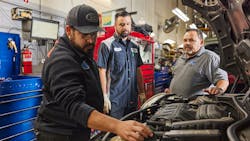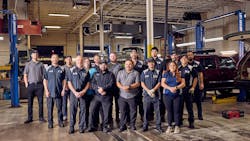Benjamin Franklin famously said, “If you fail to plan, you are planning to fail.” For auto repair shop owners, it’s not enough to have a business plan focused on operations, growth, and income goals. One major component often missing is the exit strategy—how will you get out of the business when the time comes? Yes, shop owner, there will come a day when you’re not a 20- or 30-something-year-old operator and you want to be prepared when that day comes. While succession planning sounds as morbid to many as writing a will or signing an advance directive, the importance is the same—knowing who will take the reigns of your shop when you decide to walk away.
Al Oramas of Pro Auto Care, with locations in Denver and Littleton, Colorado, opened his first shop in 1992. For many years, he wore all the hats before developing his team, which encompasses 24 employees, including his adult children. Similar to other shop owners, his focus was on growth and sustainability until one day when he asked himself at what point he wanted to transition out of the business.
Oramas took a hard look at his business. He observed the people in his charge from his managers to those who showed interest in his business. That’s when he realized the answer was closer than he thought—his children. Oramas has four kids—two boys, two girls—and all four were in the business.
“The four of them took on different roles within the company and grew those particular roles. So, that to me was probably as interesting a piece as anything because I cannot tell you how many owners of businesses, whether automotive or otherwise, (whose) kids want absolutely nothing to do with their business,” Oramas says.
He used the opportunity to allow his kids to test the waters with various roles within the shop to find their place of interest. For one daughter, he tried her hand at an administrative role but discovered she excelled at marketing where she’s now the director of marketing and customer service. Both sons worked in the shop, but one of his sons wanted a more formal role, so he completed automotive school, earned his ASE accreditations, worked as a technician for a while before becoming a service advisor.
“That's been a big piece for me, to always be able to be flexible enough to allow people to step in, grow, and try different things and guide them through the process,” Oramas says. “These are my kids, obviously, but I've done that with my employees as well.”
Though Oramas began his succession plan in 2018, he says the thought preceded the plan. In other words, the roadmap to succession was marinating for him mentally and when the opportunity to execute it became apparent, he seized it.
There are five steps to creating a successful succession plan, says Joe Marconi, executive council member and coach with Elite Worldwide. They are 1) Create a Long-Term Plan, 2) Assemble a Team of Advisors, 3) Create a Plan for the Growth of Your Business, 4) Decide Who You Want to Sell To, and 5) Prepare for Life’s Curveballs.
Step 1: Create a Long-Term Plan
Marconi says creating a long-term plan comes down to getting your thoughts onto paper—“kind of a wish list,” as he describes it—of what you want your life to look like over the next 40 years. While your goals may change down the road, knowing what you want and expressing it is paramount to creating your plan.
“It's very difficult for a young person at 25 or 30 years old, to think in terms of where am I going to be at age 65,” Marconi says. “Early on in my career, I had no desire to grow, (but) then all of a sudden, I wanted to move my business from a four-bay original to an 11-bay and then multiple locations. So, put a plan in place mapping out your five-year vision, your 10-year vision, and your long-term 25-to-35-year vision, knowing that it will change.”
Before Oramas began his succession plan, he first wanted to get some of the stumbling blocks out of the way. He paid off his debt, cleaned up his books, and remodeled his shop. Then he took account of his successors and what their potential fit in the business may look like.
“My successors are essentially my four kids, and each wants a different capacity in the business. There are those who are going to work on a day-to-day, and there are those who are looking to just have an interest in the business, mind you that may change. They may want to stake in a daily basis in the business, I understand that,” says Oramas. “So, I set for myself a 1,3,5 (year) plan. It’s how my succession plan works. I'm essentially in year No. 2 right now.”
Step 2: Assemble a Team of Advisors
With a plan in place, shop owners should seek wise counsel in the form of financial and legal professionals. According to Marconi, a certified public accountant (CPA) will help the shop stay within the good graces of the IRS while serving as a top-notch tax strategist to ensure that shop owners aren’t overpaying in taxes.
“Many shop owners, believe it or not, don't understand how the numbers work and sometimes they end up paying too much in taxes because they don't understand how to work the business in a way where they're maximizing profits and minimizing their tax liabilities,” Marconi says. “A good accountant or CPA … (will) show that you're paying only your fair share of taxes. No more, no less.”
Oramas’s CPA met with him to review the financials and go over tax impact, stock, business structure options, and transfer of ownership protocol.
Having an attorney on speed dial helps shop owners when legal questions and hurdles present. Marconi says a knowledgeable attorney is essential for discussing shop growth and expansions (if that’s within your long-range plan) how to purchase property, navigate zoning laws as well as local and state regulations.
“An attorney who has proficiency in these areas is critical when you're talking about future growth, how to expand, and the end game, plus your attorney can also help you with the will, with the estate planning, they work in conjunction with (your) financial advisor.”
As Oramas executed his succession plan, his attorney was instrumental in helping him and his family legally put the legs under their strategy. Oramas has worked with his attorney for many years and says because of that history, his counsel is better able to look after his best interest in this critical phase of ownership.
“Last year when we said, ‘Hey, it's time to roll and make this thing happen’ there was a meeting where we sat down with all the kids, and my wife, and myself, and him just talking about what the steps were going to look like—the language, the documents, the agreements, the stock, the voting shares, the non-voting shares, all of these things,” says Oramas.
The financial advisor ensures that the future you desire is fully funded while ensuring that the decisions you make today don’t jeopardize the lifestyle you want tomorrow. You may marry, have children, and eventually retire. The financial advisor ensures your money is properly allocated to meet the needs of those seasons of life.
The financial advisor has been somebody we've been working with for north of 18 years and has worked on what matters to Al and Jessica (Oramas's wife)… and he's been able to give us some strategies, been involved in looking at the bank deals, the refi, the purchase of land,” Oramas says. “He’s allowed us to put away (money) and have buckets saved.”
Having these and other key advisors in place—such as a business broker and real estate broker for growth and expansion-related deals and transactions—ensures that shop owners have the right people in their ears when key decisions need to be made.
Step 3: Create a Plan for the Growth of Your Business
Accurate numbers are at the crux of any successful succession plan. Marconi says shop owners must have a firm understanding of the data that drive their businesses. Clean financials, a strong balance sheet, and the ability to show consistent an increase in profit and sales over time—a five-year period, 10-year period, or 20-year period. Understanding your shop’s break-even point and net profit is also part of this equation.
“They need to establish those goals early on, and then map out (a) plan. What does it look like in the long term—three years, five years, 10 years, 20 years, 30 years? Can I achieve these goals? Do I need to readjust these goals in five years? And then take it from there. But you have to start with a plan right now?” Marconi says.
In 2018, the first year of his succession plan, Oramas focused on cleaning the books and eliminating debt as a means to create a financially independent shop to hand off to his kids. By 2019, he achieved his goal and made his shop financially healthy for the next phase of his succession.
“To me, (eliminating debt) was such a big piece. Full disclosure: we were staring down the barrel of almost half a million dollars worth of notes and debts. We paid it all off. Not only had everything been paid off, we had refinanced the properties that we own, we paid off one of the properties, and we have only one note now. We’ve hammered at that debt to just pay that thing down and get that balance under control. To me, financial health is all part of the making of good books and cleaning up books,” Oramas says.
Step 4: Decide Who You Want to Sell To
Planning your succession in the infancy of your business is as fun as writing a will in your 20s, but both should be done. The goal is to lay out your plan and get it as automatic as possible and then begin to seek out and raise up your successors or research potential buyers. Marconi says shop owners need to give themselves a 10-year window between training a successor or identifying a buyer and transferring ownership.
“Let's say you determine that you're going to be 55 years old when you want to get out and you’re 25 right now, that means at 45 you start the process of making a determination of who you're going to sell to. Is it going to be a family member? Is it going to be an important key employee? Build a plan. If that's too long in your mind, I would say no shorter than five years before that date you want to sell, build a plan around that,” Marconi says.
Oramas is preparing his four kids—oldest son, Alex; twin girls Leah and Lenea; and youngest son, Carlos—to take over his business in the next few years. Each is entrenched in the business and the teams at his shop—starting with his managers—are fully aware of and supportive of the incoming change of leadership.
“I start with the managers first. The managers have to know the plan. They have to know what I'm doing ... and they're seeing my family—my kids if you would, my successors—assuming roles of responsibility and administration and becoming comfortable with it, versus me walking up on a Monday morning and saying, 'Hey, everybody, I'm not going to be here and so and so's taking over.' No, I've made it deliberate when they are taking an active role,” says Oramas, adding that he also meets with his kids to bridge the gaps for them, as well.
“On a weekly basis, I have carved out time for meetings with them to talk to them about what we're doing and how we're doing. Give a safe place to ask questions of unknowns and try to help them. I try not to overwhelm … That to me is the essence of a good transfer. If you transfer in title alone, you won't succeed.”
Step 5: Prepare for Life’s Curveballs
In the Allstate “Mayhem” commercials, Dean Winters personifies unforeseen circumstances to remind viewers that anything outside of their control can happen at any time. The same is true of shop owners. Life can change in pleasant ways—marriage, children, a first home— or in unpleasant ways—an accident, long-term illness, or death. Shop owners need to consider each in their succession plan.
Marconi says shop owners should have enough insurance to cover the needs of their family and take care of the mortgage should they meet an untimely death and have a written will outlining what happens to the assets. “ You don't want to leave it to the government or to probate to make those decisions for you,” Marconi says.
A continuity plan for the shop is also a must-have document. This spells out who will do what in the business should a shop owner need to be out of the business for an undisclosed period of time for any reason.
“Let's say you get sick, but you're not willing to give up the business and you don't have to, but you're going to be out for a considerable amount of time, what takes place in the interim? Who runs the business? Is there a second in command? Does everybody know how to conduct the business in your absence,” Marconi says.
Though succession planning takes time and foresight to create and implement, shop owners should see this as a part of their business plan. Understanding your overall goals for your business, assembling allies to help along the way, projecting your growth, choosing your next in line, and planning for outside variables that can affect you and your business is mission critical to the successful launch, growth, and continuity of your auto repair shop.









